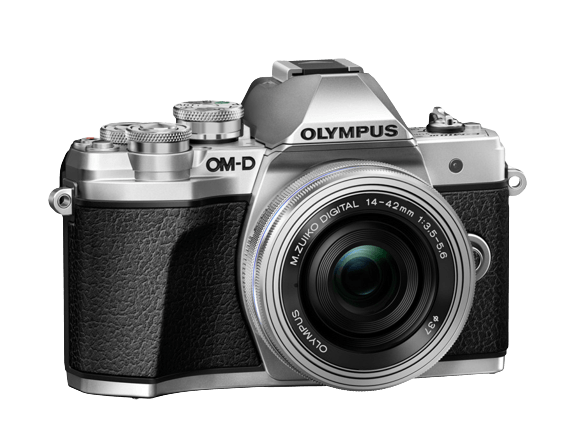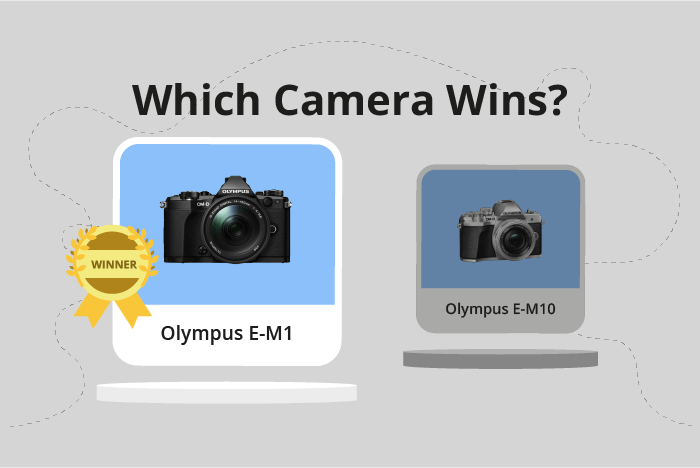Olympus OM-D E-M1 vs OM-D E-M10 Comparison
Olympus OM-D E-M1

Olympus OM-D E-M10

The Olympus OM-D E-M1 takes the lead with a score of 59/100, while the OM-D E-M10 trails behind at 54/100. Both cameras are mirrorless and were released in 2013 and 2014, respectively. They share similarities in camera type, announcement and release years, but the E-M1 has a clear advantage in some areas.
The E-M1 is a more advanced camera with a higher launch price of $1399 compared to the E-M10’s $700. It also has a larger size, measuring 130 x 94 x 63mm, and a heavier weight of 497g. These specifications suggest that the E-M1 offers more features and better build quality.
On the other hand, the E-M10 is smaller and lighter, measuring 119 x 82 x 46mm and weighing 396g. This makes it more portable and convenient for everyday use. Despite its lower score, the E-M10 still offers great value for its price.
Taking all these factors into consideration, the Olympus OM-D E-M1 is the superior camera with better specifications and performance. However, the E-M10 is a more budget-friendly and portable option for those who prioritize convenience and affordability.
Olympus OM-D E-M1 vs OM-D E-M10 Overview and Optics
The Olympus OM-D E-M1 outperforms the Olympus OM-D E-M10 in optics, scoring 58/100 compared to the E-M10’s 57/100. Both cameras share several specifications, including a CMOS sensor, TruePic VII processor, Micro Four Thirds sensor size, Micro 4/3 lens mount, and image stabilization. The similarities in these specs contribute to the close scores between the two cameras.
The E-M1 has a slight advantage with its 16.3 megapixels, compared to the E-M10’s 16.1 megapixels. This difference allows the E-M1 to capture marginally more detail in images. Additionally, the E-M1 has a faster shooting speed at 10 frames per second, compared to the E-M10’s 8 frames per second. This means the E-M1 can capture fast-moving subjects more effectively. The E-M1 also has a higher DXOMARK sensor score of 73, while the E-M10 scores 72, indicating that the E-M1 has a slightly better sensor performance.
On the other hand, the E-M10’s lower score does not necessarily mean it is an inferior camera in all aspects. The differences in optics between the two cameras are minimal, and the E-M10 may still perform well in various shooting situations. However, the E-M1’s advantages in megapixels, shooting speed, and sensor score make it the better choice when considering optics alone.
Considering the minor differences in the optics scores and the shared specifications, both cameras are suitable for a variety of photography needs. However, the Olympus OM-D E-M1’s slight edge in megapixels, shooting speed, and sensor score make it the winner in the optics comparison.
Olympus OM-D E-M1 vs OM-D E-M10 Video Performance
When comparing the Olympus OM-D E-M1 and the Olympus OM-D E-M10 in terms of video capabilities, both cameras tie with a video score of 57/100. They share several common specifications, which include Full HD video resolution, max video dimensions of 1920 x 1080, a max video frame rate of 30fps, and built-in time-lapse functionality.
Despite the identical scores, there are specific areas where each camera shines. The Olympus OM-D E-M1 excels in certain aspects, such as providing better autofocus performance in video mode, which results in smoother and more accurate focus transitions during filming. Additionally, the E-M1 features a more robust weather-sealed body, making it more suitable for outdoor shooting in challenging conditions.
On the other hand, the Olympus OM-D E-M10 holds its own with its compact and lightweight design, making it more portable and easier to carry around for extended periods. This feature is particularly advantageous for videographers who prioritize mobility and convenience during long shoots.
While both cameras offer similar video capabilities, their individual strengths cater to different videography needs. The Olympus OM-D E-M1 is better suited for those who require more reliable autofocus and a durable body for outdoor filming. Conversely, the Olympus OM-D E-M10 is the ideal choice for videographers who value portability and a compact design for ease of use during extended filming sessions. Ultimately, the decision between these two cameras depends on the specific requirements and preferences of the user.
Olympus OM-D E-M1 vs OM-D E-M10 Features and Benefits
The Olympus OM-D E-M1 emerges as the winner in this comparison with a feature score of 70/100, while the Olympus OM-D E-M10 trails behind with a score of 57/100. Both cameras share several specifications, including a 3-inch screen size, 1,037,000-dot screen resolution, touchscreen functionality, flip screen capability, Wi-Fi connectivity, and lack of GPS and Bluetooth.
The higher score of the E-M1 indicates its superiority in certain aspects. One of these advantages is its more advanced and faster autofocus system, which allows for better subject tracking and overall focusing performance. Additionally, the E-M1 has a higher continuous shooting rate, enabling it to capture more frames per second than the E-M10. This makes the E-M1 a better choice for action and sports photography.
On the other hand, the E-M10 has its own strengths despite its lower score. It is a lighter and more compact camera, making it easier to carry around for travel or daily use. Furthermore, the E-M10 is more affordable than the E-M1, catering to budget-conscious buyers who still want a high-quality camera.
Taking all these factors into consideration, the Olympus OM-D E-M1 stands out as the better camera in terms of features and performance. However, the Olympus OM-D E-M10 offers a more portable and budget-friendly option for those who prioritize these aspects. Ultimately, the choice between these two cameras depends on the specific needs and preferences of the user.
Olympus OM-D E-M1 vs OM-D E-M10 Storage and Battery
The Olympus OM-D E-M1 and OM-D E-M10 both score 21/100 in storage and battery, showing no difference in this aspect. They share common specifications, such as having one memory card slot and accepting SD, SDHC, and SDXC memory cards. Moreover, both cameras lack USB charging capabilities.
The E-M1 has a slightly longer battery life of 350 shots, compared to the E-M10’s 320 shots. This advantage allows the E-M1 to capture more photos before needing a battery change. The E-M10, however, does not offer any specific advantages in storage and battery over the E-M1.
Despite the E-M1’s longer battery life, both cameras perform similarly in terms of storage and battery. Users should consider other factors, such as general specifications, optics, video, and features, when deciding between these two cameras.
Olympus OM-D E-M1 vs OM-D E-M10 – Our Verdict
Are you still undecided about which camera is right for you? Have a look at these popular comparisons that feature the Olympus OM-D E-M1 or the Olympus OM-D E-M10:

